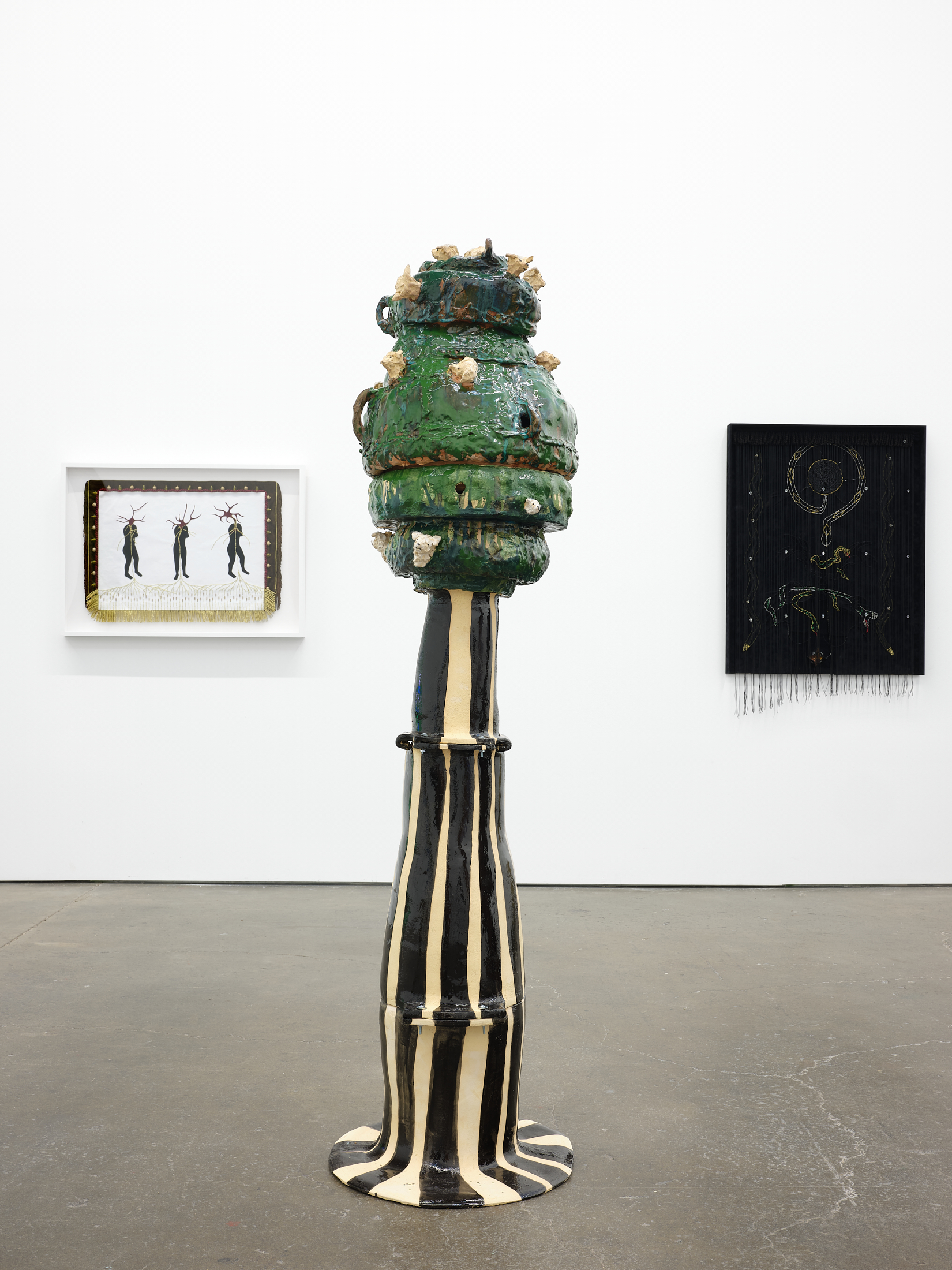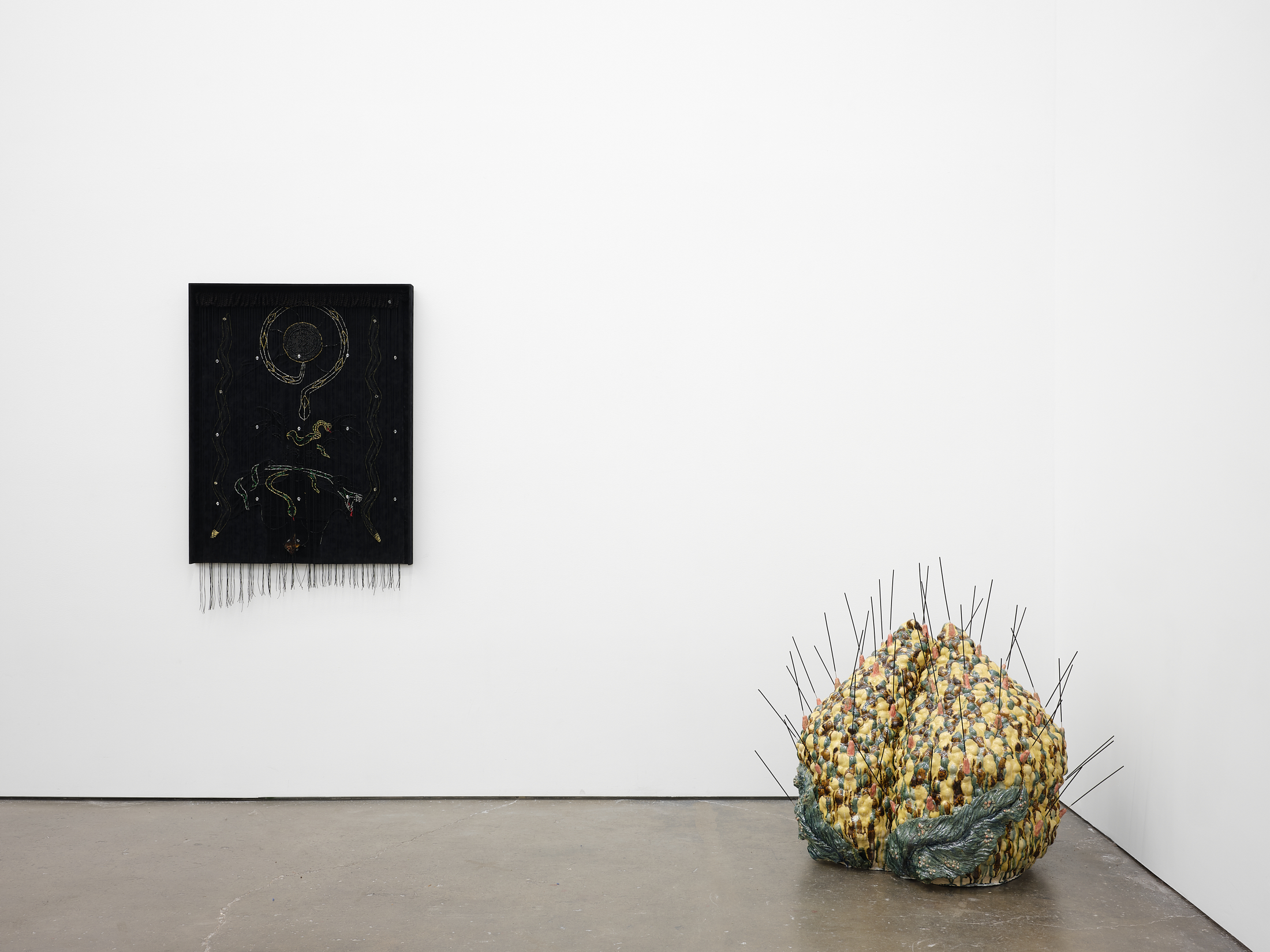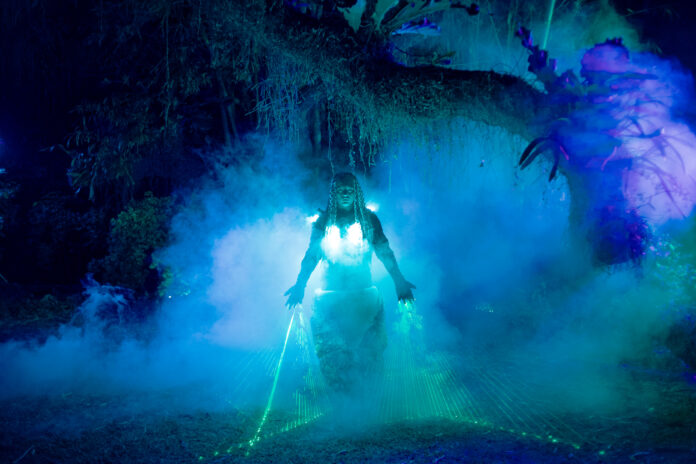Under the Waqwaq Tree is an invitation into a sensorial imaginary, a dream made corporeal. On view at the gallery / (slash) in San Francisco, this otherworldly group exhibition curated by Naz Cuguoğlu draws its title and conceptual foundation from a symbol in Arab art and literature, the waqwaq tree bears fruit in the form of female figures, who cry “waq waq!” upon ripening and falling from its branches. From this notion, Cuguoğlu imagines an unruly world of myths and monsters that defy convention and boundary. Alongside the gallery exhibition, Collective Çukurcuma (of which Cuguoğlu is part) hosts a reading group and provides a recommended reading list, with entries from exhibiting artists and emphasis on Cuguoğlu’s grounding in speculative fiction. These participatory activations open the exhibition beyond gallery walls, finding new ways to delve into the worlds imagined in Under the Waqwaq Tree.

Distorted, disorienting rhythms from Patricia Domínguez’s multimedia installation Madre Drone fill the main gallery, with sharp reverberations that transport viewers into the exhibition’s multiple realities. At the center of Madre Drone is a mesmerizing video that uses a holographic projection to evoke but ultimately elude tactility. A video playing atop a grey stone altar features documentation of 2019 social uprisings in Santiago, Chile, where protestors used green lasers to disable the visual field of drones and counter state surveillance. The piece, installed in the gallery’s back corner, triangulates resistance as a core theme in Under the Waqwaq Tree.
“Can you prove it did not happen?,” Cuguoğlu asks in her poetic curatorial statement, challenging the notion of mythology as fiction. The exhibition is indeed fantastical, but its uncanny representations of human and plant life tell the story of subconscious worlds that run parallel alongside our own surface realities. Cuguoğlu’s curation is as much about bringing works into dialogue as it is world-building.
In the gallery center stands Khoury’s ceramic sculpture Untitled (Esther tree), one of several invocations of the tree motif. Heads of the artist’s dog Esther grow out of green-glazed mounds atop a striped pedestal, a simultaneously whimsical and unsettling gesture. Trees are also represented in Ranu Mukherjee’s work that portrays the banyan tree. In A Bright Stage, a duo of angular forms of electric green and blue fabric draw the gaze upwards, stretching towards the sky and towards dreaming. As if fallen from one of the many trees, Cathy Lu’s Peach 2 rests in a far corner, an unsettling rendering of the fruit. Its surface is covered with growths in sickly pale greens and yellows, with spines (made of incense sticks) growing out of pink globs. Overripened to the edge of rot, the normally-tantalizing peach refuses desire. Anna Betbeze’s Eden is a lushly dark fiber work with ombres of pinks, yellows, and oranges that form an abstracted tree-like figure. Viewing Eden activates a synesthetic experience of sight as touch; gazing into the work suddenly feels like running one’s fingers through its wild fibers until becoming totally enveloped in it.

Cuguoğlu has also populated the exhibition with beings who navigate its environs. Drawing attention skyward is the figure in Mukherjee’s dear future, where a long-haired figure with back turned and arms raised transforms into a tree, becoming home to a menagerie of birds. Katie Dorame’s Other Side – Barbara as Sea Witch depicts the bust of a cloaked, masked figure whose entrancing eyes and leaning posture pull you in their direction. The figure in Dorame’s Other Side – Anna May Veiled seems to be casting a protective spell, with a rippling auric plasma extending from the figure’s hands. Under the Waqwaq Tree also explores interrelational connectivity; in this speculative world there are invisible threads between its inhabitants that draw power and protection. Shervone Neckles’ you are your best thing shows three tree-like human figures who are bonded by underground roots of gold embroidered thread. The piece speaks to a delicate, enduring relationship to land and each other, recalling tree groves where each individual is part of an indivisible whole.
Entering and exiting the gallery, viewers encounter the mercurial figures of Michelle Handelman’s Irma Vep, The Last Breath. Centered on the character Irma Vep (an early 20th century French silent film character) and Musidora (the actress who played Irma Vep), Handelman depicts black-clad shadow figures slinking through a decaying urban landscape and techno-futurist stage sets. Engaging artists Zachary Drucker and Flawless Sabrina to portray Irma Vep and Musidora respectively, Handelman’s work crosses temporal lines of fiction and reality to further unsettle the exhibition’s multifaceted world.
Inhabiting and forming the worlds of Under the Waqwaq Tree are beings that refuse to be othered or defined. The worlds they create are mutating, unfurling, proliferating. They do not ask for space, they make it.
UNDER THE WAQWAQ TREE runs through January 22. / (slash), SF. More info here.
Help us save local journalism!
Every tax-deductible donation helps us grow to cover the issues that mean the most to our community. Become a 48 Hills Hero and support the only daily progressive news source in the Bay Area.




